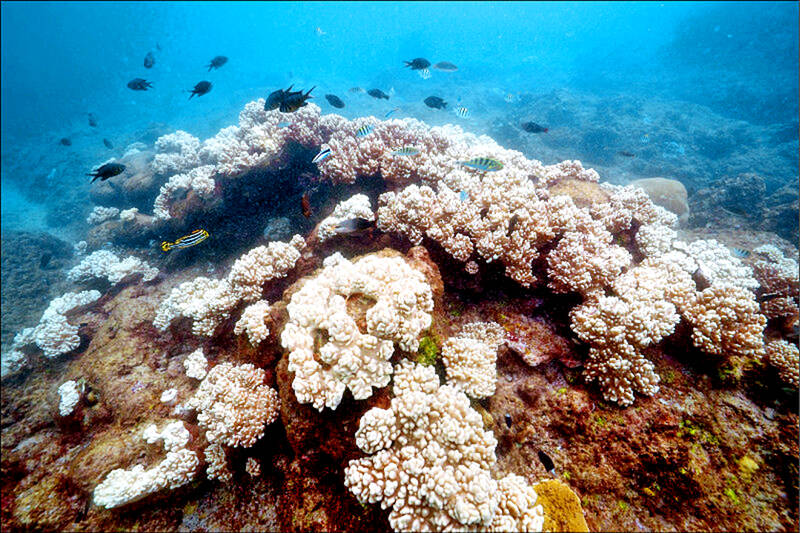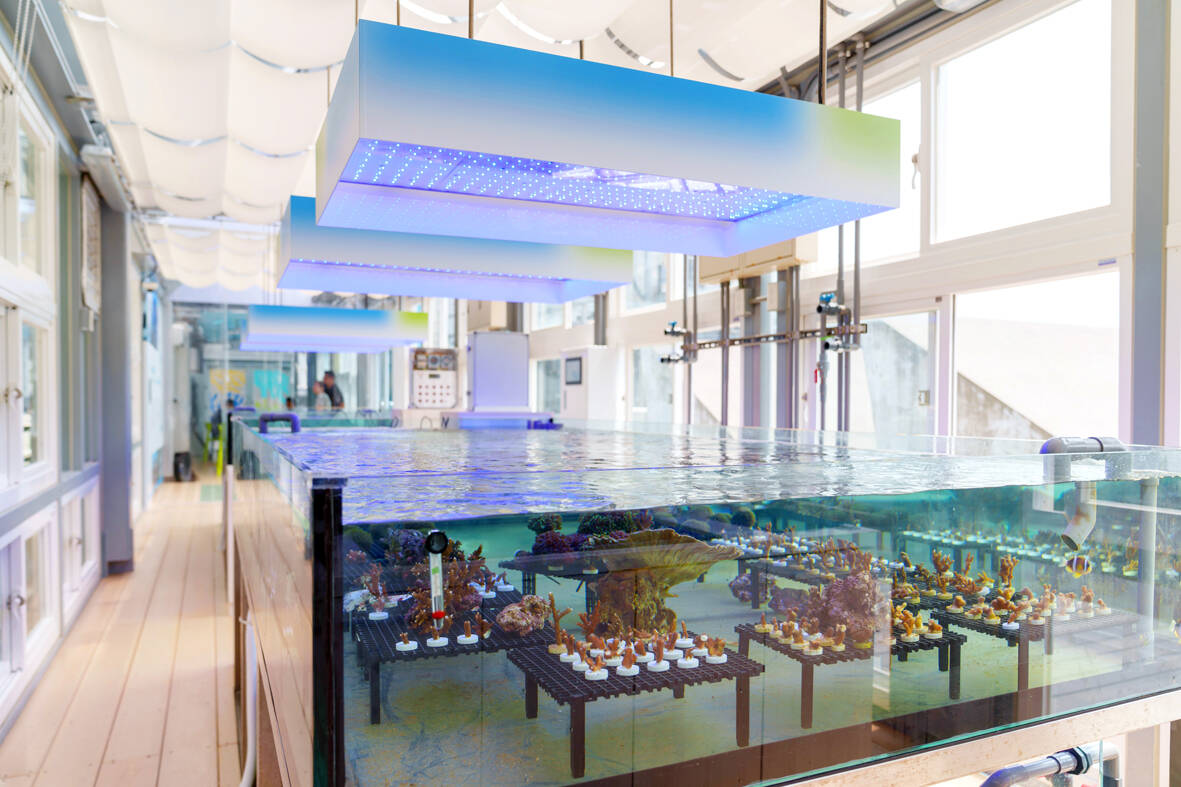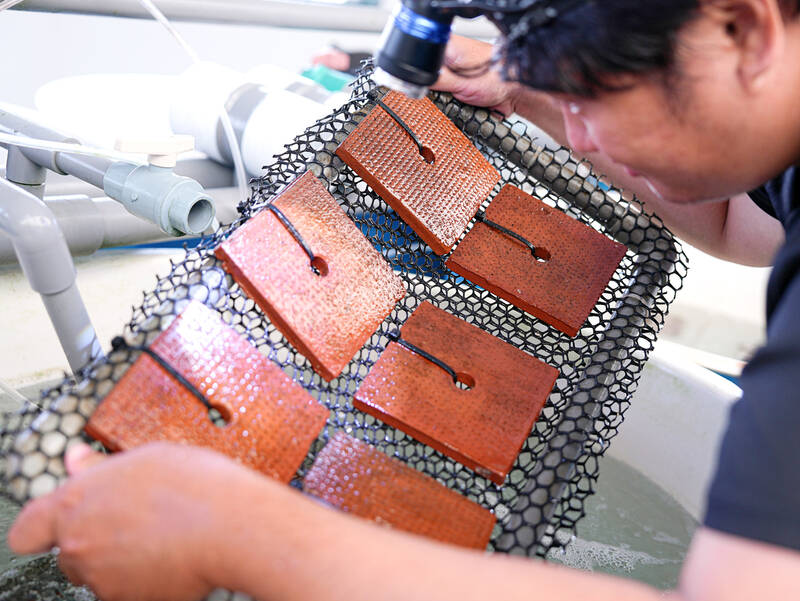Throughout the world, coral reef ecosystems are withering as a result of climate change and warming oceans. Some of the reefs around Taiwan, such as those close to Pingtung County’s Siaoliouciou Island (小琉球), have already suffered massive and perhaps irreversible damage.
Corals get their color from single-cell photosynthetic organisms called zooxanthellae. If they become stressed by high temperatures or pollution, they expel these zooxanthellae and revert to a stark whiteness. This “bleaching” isn’t necessarily fatal. When the period of stress is brief, the zooxanthellae are often able to return. If it’s prolonged, however, the consequences can be devastating, both for the corals themselves and for the many marine species that shelter and spawn within reefs.
Even where conditions make it possible for a new reef to appear, it takes an eternity: Up to 10,000 years for a typical reef, “while barrier reefs and atolls can take from 100,000 to 30 million years to fully form,” says the Web site of the US National Oceanic and Atmospheric Administration.

Photo: Taipei Times file photo
Several of Taiwan’s coral reefs experienced severe bleaching in 2020. The gradual rise in water temperatures wasn’t the only cause. Because there were no typhoons that year, at the height of summer there was less churning of cooler water from the ocean depths.
The extent of the bleaching was obvious, both to specialists such as the Taiwan Coral Bleaching Observation Network and to amateur divers. Among the latter was an engineer working for Taiwan-based manufacturer Delta Electronics Inc. Photos the employee took of bleached corals at Houbihu Fishing Harbor (後壁湖魚港), adjacent to Kenting National Park, inspired staffers at Delta Electronics Foundation (DEF) — a climate-focused NGO established by the company in 1990 — to look into whether existing climate mitigation projects might suggest ways in which humanity can help imperiled coral reefs.
According to emailed responses from the DEF, they soon discovered there was “a great need for cross-sectoral collaborations on coral restoration and research, and that Delta’s technology could play a crucial role.”

Courtesy of Delta Electronics Foundation.
The foundation’s first step was to equip corporate volunteers “with the best-available knowledge of coral ecosystems and restoration.” In 2021, working with marine conservation professionals, Delta converted an abandoned abalone culture pond on Taiwan’s northeast coast into a coral nursery.
Collaborating with the National Museum of Marine Science & Technology (NMMST), Delta last year established the Chaojing Coral Conservation Center within Keelung’s Wanghaixiang Chaojing Bay Resource Conservation Area (望海巷潮境資源保育區). The center is a location for ex-situ conservation work (the breeding and maintenance of endangered organisms under partly or wholly controlled conditions) “prioritizing the conservation of 20 native coral species on the International Union for Conservation of Nature (IUCN) Endangered and Vulnerable Coral List,” the DEF says.
The center aims to foster over 10,000 corals within three years. At the same time, Delta volunteers are assisting NMMST scientists to research coral reproduction and heat-resilient coral species cultivation.

Photo courtesy of Orsted
Emphasizing that the DEF makes a long-term commitment to each project it supports, Delta is backing the coral restoration effort with technology, funding and manpower. The coral breeding system is based on the company’s vertical farming technology, and incorporates Delta’s lighting and industrial automation solutions.
“Following collaboration between NMMST scientists and Delta engineers, initial test results showed a 40 to 50 percent increase in growth rates for certain coral species, compared to in-situ samples,” Delta says.
Delta’s micro-computed tomography equipment is being used to generate 3D X-ray images with pixel sizes down to one micrometer. (Human hair is 20 to 40 micrometers in width.) This allows scientists to analyze coral bone density and soft tissue, and to study coral calcification mechanisms and skeleton structure in detail, adding to humanity’s understanding of endangered corals.

Photo courtesy of Orsted
WIND FARM CORAL REEFS?
Among the multinational enterprises involved in Taiwan’s ambitious wind-energy program is Orsted A/S. The Denmark-headquartered company is partnering with the Penghu Fisheries Research Center (a unit of the Ministry of Agriculture’s Fisheries Research Institute) in a human intervention to support coral habitat on the foundations of four turbines within the Greater Changhua offshore wind farms between 35km and 50km from Taiwan’s west coast.
These locations offer stable sea temperatures of 20 to 25 degrees Celsius in which, it’s hoped, corals can thrive. Coral reefs don’t form in deep water because zooxanthellae rely on sunlight for photosynthesis, but — as Orsted’s Web site explains — on designated areas of turbine foundation structure, “corals will have good access to light while being protected from extreme temperatures by the natural circulation of the cooler, deeper water the turbines stand in.”
Orsted’s ReCoral project is still at the proof-of-concept stage, says Lee Chih-an (李之安), the company’s Asia Pacific’s senior sustainability advisor.
The first step was the collection of approximately 200,000 coral eggs as they washed ashore in the Penghu archipelago in the spring of 2022. Lee says that taking even this great number doesn’t undermine the natural reproduction of coral in the ocean, as many species release vast surpluses of gametes.
That summer, 10,000 lab-cultivated coral larvae were shipped out to the turbines and released. As with many first attempts, it wasn’t a great success.
“The results of the 2022 offshore seeding of coral larvae indicate that the water column may be too challenging for coral larvae to compete for living,” says Lee. She adds that, while the ocean’s temperature and salinity were comparable to lab conditions in which the larvae had thrived, “factors such as waves, current and keen competition with other benthic animals like mussels and barnacles” complicated the picture.
In May and June last year, researchers once again went out to gather coral spawn, which they then seeded on brick tiles and cultured in the laboratory at Penghu Fisheries Research Center.
“A thermostatic system and artificial lighting were installed, to keep the corals alive throughout the winter by ensuring the temperature stays close to 23 degrees Celsius. This should make them strong and healthy, and give them a better chance of surviving the offshore environment,” says Lee.
For the next attempt, lab-grown one-year-old and two-year-old corals (the 2022 and last year’s “crops”) will be moved to the wind farm. That is expected to give scientists a better idea as to the location’s suitability for corals, and also yield data that could assist coral restoration efforts in other parts of the world.
Some researchers say the best way to future-proof coral reefs could be through the cultivation of climate-resilient corals. If scientists can bolster corals’ heat tolerance through selective cross-breeding, or by conditioning and acclimating certain species to gradual increases in water temperature, humanity might be able to reduce the severity of bleaching events. Given the importance of reefs to marine biodiversity and fisheries, and their role in mitigating storm surges and land erosion, we should grasp at any straw we see.
Steven Crook, the author or co-author of four books about Taiwan, has been following environmental issues since he arrived in the country in 1991. He drives a hybrid and carries his own chopsticks. The views expressed here are his own.

Most heroes are remembered for the battles they fought. Taiwan’s Black Bat Squadron is remembered for flying into Chinese airspace 838 times between 1953 and 1967, and for the 148 men whose sacrifice bought the intelligence that kept Taiwan secure. Two-thirds of the squadron died carrying out missions most people wouldn’t learn about for another 40 years. The squadron lost 15 aircraft and 148 crew members over those 14 years, making it the deadliest unit in Taiwan’s military history by casualty rate. They flew at night, often at low altitudes, straight into some of the most heavily defended airspace in Asia.

Many people in Taiwan first learned about universal basic income (UBI) — the idea that the government should provide regular, no-strings-attached payments to each citizen — in 2019. While seeking the Democratic nomination for the 2020 US presidential election, Andrew Yang, a politician of Taiwanese descent, said that, if elected, he’d institute a UBI of US$1,000 per month to “get the economic boot off of people’s throats, allowing them to lift their heads up, breathe, and get excited for the future.” His campaign petered out, but the concept of UBI hasn’t gone away. Throughout the industrialized world, there are fears that

Like much in the world today, theater has experienced major disruptions over the six years since COVID-19. The pandemic, the war in Ukraine and social media have created a new normal of geopolitical and information uncertainty, and the performing arts are not immune to these effects. “Ten years ago people wanted to come to the theater to engage with important issues, but now the Internet allows them to engage with those issues powerfully and immediately,” said Faith Tan, programming director of the Esplanade in Singapore, speaking last week in Japan. “One reaction to unpredictability has been a renewed emphasis on

Taiwan’s democracy is at risk. Be very alarmed. This is not a drill. The current constitutional crisis progressed slowly, then suddenly. Political tensions, partisan hostility and emotions are all running high right when cool heads and calm negotiation are most needed. Oxford defines brinkmanship as: “The art or practice of pursuing a dangerous policy to the limits of safety before stopping, especially in politics.” It says the term comes from a quote from a 1956 Cold War interview with then-American Secretary of State John Foster Dulles, when he said: ‘The ability to get to the verge without getting into the war is